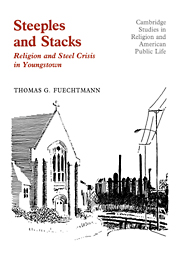Book contents
- Frontmatter
- Contents
- List of Tables and Figures
- Acknowledgments
- Introduction
- I Steeltown
- II The Industry
- III Shutdown
- IV Coping with Crisis: Community Response to the Shutdown
- V Religion and Urban Economic Crisis
- VI Launching a Movement
- VII The Plan
- VIII Negotiations
- IX Ending, Learning, Beginning Anew
- X Epilogue
- Notes
- References
- Index
VIII - Negotiations
Published online by Cambridge University Press: 29 March 2010
- Frontmatter
- Contents
- List of Tables and Figures
- Acknowledgments
- Introduction
- I Steeltown
- II The Industry
- III Shutdown
- IV Coping with Crisis: Community Response to the Shutdown
- V Religion and Urban Economic Crisis
- VI Launching a Movement
- VII The Plan
- VIII Negotiations
- IX Ending, Learning, Beginning Anew
- X Epilogue
- Notes
- References
- Index
Summary
Moving the reopening plan from idea to reality called for the Coalition to conduct a complex series of negotiations in both the private sector and the public sector. On occasion, the site for these negotiations might be Lykes offices in Tampa or the National Council of Churches office in New York. But the two principal places of action were Youngstown and Washington.
In Youngstown, not only did the Coalition have to develop public support through campaigns such as the Save Our Valley savings accounts. It was also necessary to piece together the support of a network of government agencies at the local level. This sometimes involved reconciling some intense territorial and political rivalries. In addition, the Coalition had to do some hard bargaining, first with Lykes and then with Jones and Laughlin over a purchase agreement for the shutdown portion of the Campbell Works. On the whole, negotiations at the Youngstown end emerged successfully. It was in Washington that negotiations failed.
Negotiating with the Steel Companies
In order to reopen the Campbell Works under a new ownership plan, one of the first items to be negotiated was the purchase of the mill property. An early meeting with local Sheet and Tube executives in January 1978 was held to explore the possible terms and conditions of a sale. According to Stanton, it was apparent at this point that the steel company was not taking the Coalition inquiry very seriously. When pressed for a ball-park purchase price for the shutdown facilities, the figure of $67 million was named, an amount the Coalition considered out of the question.
- Type
- Chapter
- Information
- Steeples and StacksReligion and Steel Crisis in Youngstown, Ohio, pp. 235 - 258Publisher: Cambridge University PressPrint publication year: 1989

